 |
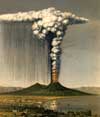
Courtesy of Benedetto De
Vivo
|
Compositional
variations of Plio-Quaternary volcanism in
Italy:
Deep vs. shallow mantle processes
|
|
|
|
Abstract
Plio-Quaternary volcanism in Italy
shows strong compositional variations, which reveal
heterogeneous mantle sources spanning both subduction-related
and intraplate compositions.
Major and incompatible trace element
abundances and ratios show variable values, which
allow several compositionally distinct magmatic provinces
to be distinguished. These are separated by deep faults
and are characterised by distinct lithospheric mechanical
characteristics, e.g., Moho depth and lid
thickness. Radiogenic isotope compositions (Sr, Nd,
Pb) of mafic rocks show continuous variations connecting
three distinct mantle reservoirs: HIMU-FOZO, EM2 and
a high-87Sr/86Sr low-206Pb/204Pb
mantle reservoir. The latter is typical of the Italian
region and is called ITEM (Italian Enriched Mantle).
The smooth trends of radiogenic isotopes
have been interpreted as mixing between deep reservoirs,
emplaced into the upper mantle by uprising plumes.
However, the strong regionality of major and trace
elements, together with structural geology and geophysical
evidence, support shallow mantle processes in the
generation of Italian Plio-Quaternary magmatism.
|
| Introduction
Plio-Quaternary magmatism in
Italy (Figure 1) is extremely variable in composition,
spaning almost the entire spectrum of magmatic
rocks occurring world-wide. Volcanic rocks range
from subalkaline (tholeiitic and calcalkaline)
to Na- and K-alkaline and ultra-alkaline, from
mafic to silicic, and from oversaturated to strongly
undersaturated in silica (Figure 2). Trace element
contents are also highly variable, covering both
intra-plate and orogenic compositions (Figure
3). This extreme diversity requires a complexly
zoned mantle, revealing an unusual geotectonic
setting. Understanding the origin and evolution
of the mantle beneath Italy is a challenge for
igneous petrology, geochemistry, and geodynamics. |
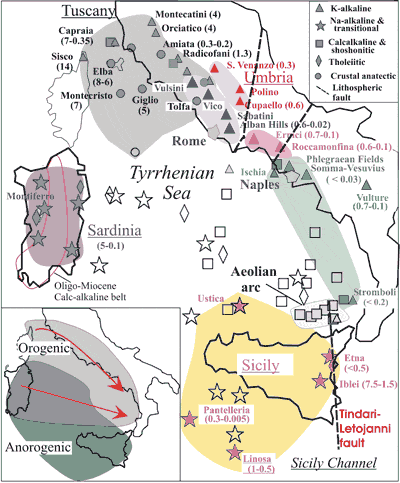
Figure 1: Distribution of
Recent magmatism in Italy. Open symbols indicate
seamounts. Ages (in Ma) are given in parentheses.
Different colours denote various magmatic provinces.
Inset: schematic distribution of orogenic and
anorogenic volcanism: red arrows show migration
of orogenic magmatism with time. Click
on figure for enlargement. |
|
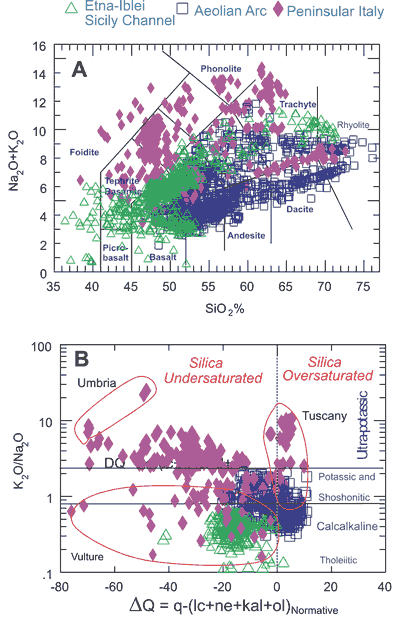 |
Figure 2. A:
Total alkali vs. silica classification diagram
for Italian Plio-Quaternary magmatic rocks (Peccerillo,
2002). B: delta-Q vs. K2O/Na2O
classification diagram for Plio-Quaternary mafic
volcanic rocks (MgO > 4%) from Italy. Delta-Q
is the algebraic sum of normative quartz (q),
minus leucite (lc), nepheline (ne), kalsilite
(kal) and olivine (ol). Silica oversaturated rocks
have delta-Q > 0, whereas silica undersaturated
rocks have delta-Q < 0. Click on figure for
enlargement. |
|
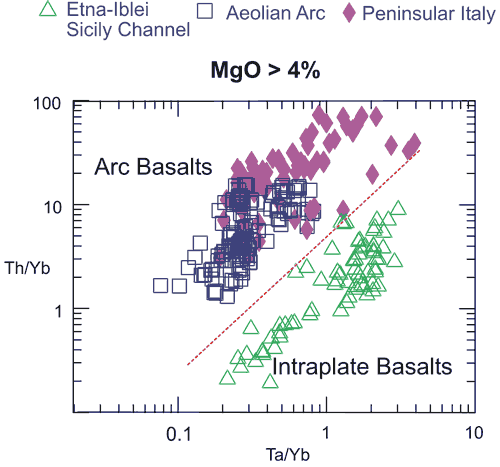
Figure 3: Th/Yb vs. Ta/Yb diagram
for Plio-Quaternary mafic rocks from Italy, discriminating
between intraplate and arc basalts. |
Regional
distribution of magma types
There is a strong correlation between
the petrological characteristics of Plio-Quaternary
magmas in Italy and their regional distribution (Figure
1). Tholeiitic, transitional and Na-alkaline rocks
with typical intraplate geochemical signatures (e.g.,
low LILE/HFSE ratios, Figure 3) occur in western Sicily
and Sicily Channel (Etna, Iblei, Linosa, Pantelleria),
in Sardinia (Lustrino et al., 2000), and
in the Tyrrhenian Sea (e.g. Ustica). Calcalkaline,
shoshonitic and K-alkaline rocks with island-arc
geochemical signatures (high LILE/HFSE ratios, Figure
3) are concentrated in the Aeolian arc, and along
the Tyrrhenian side of the Italian peninsula, but
also occur as seamounts on the Tyrrhenian Sea floor.
Orogenic magmas display an overall decrease in age
from west to south-east (Figure 1, inset). |
Regional
variation of trace element and Sr-Nd-Pb isotope compositions
of mafic rocks
Italian Plio-Quaternary
magmatism mostly consists of intermediate and
silicic rocks, derived from a mafic parent by
complex evolutionary processes. Mafic rocks (MgO
> 4 wt%) occur in minor amounts but they are
particularly helpful for understanding mantle
composition and processes. Mafic rocks in Italy
have variable abundances and ratios of incompatible
trace elements (Figure 4). These are rather independent
on the major petrological characteristics and
are strongly correlated with regional distribution.
For instance, calcalkaline and shoshonitic rocks
from Tuscany, in the north, fall into a distinct
field with respect to rocks of equivalent petrologic
composition from the Aeolian arc (Peccerillo,
1999, 2002). Such a strong regionality of trace
element characteristics allows several magmatic
provinces to be distinguished (Figure 1). These
provinces are also characterised by their distinct
lithospheric structures, e.g., Moho depth,
lid thickness and depth of earthquake foci, (Peccerillo
& Panza, 1999) and are often divided
by fault systems that are transverse to the volcanic
belt and to the Apennine chain (Figure 1). |
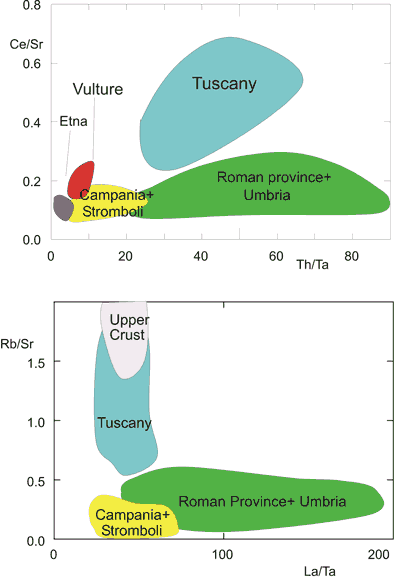
Figure 4: Incompatible trace
element ratios in mafic Plio-Quaternary volcanic
rocks from Italy. Note the strong regional variation. |
Radiogenic isotope compositions (Sr,
Nd, Pb, Hf) define smooth trends (Figure 5). There is
an overall increase of 87Sr/86Sr
and a decrease of 143Nd/144Nd
and Pb isotopes from south to the north, with the various
regions displaying distinct isotopic signatures.
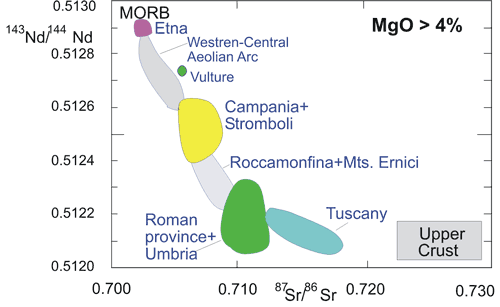
Figure 5: Sr-Nd isotope diagram
for Plio-Quaternary mafic volcanic rocks from Italy.
Note the strong regional variation.
The 87Sr/86Sr vs. 206Pb/204Pb
diagram (Figure 6) reveals that all magmatism in Italy
may be described in terms of interaction between three
end-members:
- A low – 87Sr/86Sr
high – 206Pb/204Pb end-member,
close to HIMU or FOZO. The main representatives
of this reservoir are rocks from Etna, Iblei and
Ustica.
- A low – 206Pb/204Pb
low – 87Sr/86Sr
end-member, resembling EM1. Such rocks occur in
Sardinia.
- A high – 87Sr/86Sr
low – 206Pb/204Pb end-member
with Pb isotopic ratio close to EM2, but with much
higher 87Sr/86Sr. This has
been called ITEM (Italian Enriched Mantle) by Bell
(2002) and is represented by ultrapotassic rocks
from central Italy.
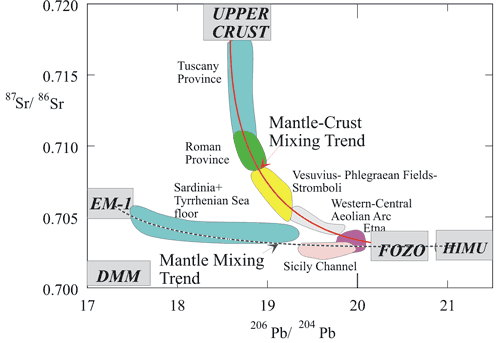
Figure 6: 87Sr/86Sr
vs. 206Pb/204Pb variations of
Plio-Quaternary Italian mafic rocks. Central Italy
orogenic magmatism falls along a mantle-crust mixing
trend involving HIMU-FOZO and Upper Crust. Sicily,
Sicily Channel, Sardinia and some Tyrrhenian Sea seamounts
(anorogenic magmatism) plot along a mantle-mantle
mixing trend involving two or three end members (HIMU-FOZO,
EM1, and DMM).
Petrogenesis
The variable petrological characteristics
of Italian Plio-Quaternary magmatism call for a wide
variety of mantle compositions and petrogenetic processes,
including degrees and pressure of partial melting,
mantle mineral compositions, and fluid pressure. The
Na-alkaline rocks are believed to be generated in
mantle sources similar to those of OIBs. Calcalkaline,
shoshonitic and potassic rocks show many geochemical
characteristics in common (e.g., high LILE/HFSE
ratios), although they display different enrichments
in incompatible elements. These rocks are probably
derived from anomalous mantle sources which were enriched
in incompatible elements by the subduction processes.
There is a debate about the age of mantle enrichment.
It has been suggested to have occurred during the
Tertiary evolution of the Alpine-Apennine chains (Peccerillo,
1999), or at some 1-2 Ga (e.g., Castorina
et al., 2002). Establishing the age of mantle
contamination has profound implications for understanding
the geodynamic evolution of the Tyrrhenian Sea and
surrounding areas (see Peccerillo, 1999,
2002 for discussion). |
Geodynamic
significance: Plume vs. shallow mantle processes
Much of the discussion on the geodynamic
significance of Italian Plio-Quaternary magmatism has
addressed the problem of whether it relates to subduction
processes or represents intraplate magmatism possibly
connected with the emplacement of deep mantle plumes
(e.g., Ayuso et al., 1997; Peccerillo,
1999, 2002, 2003;
Gasperini et al., 2002; Bell, 2002).
Some authors suggest that only the Etna-Iblei-Ustica
(i.e., HIMU-FOZO) and Sardinia (i.e.,
EM2) rocks derive from mantle plumes, whereas the
rest of the magmatism represents mixtures of plume
material and subducted upper crustal components (Gasperini
et al., 2002). Other authors suggest the more
extreme hypothesis that all the magmatism reflects
interaction among various plume reservoirs (Bell,
2002).
Evidence
invoked in favour of the plume hypothesis includes:
-
The ultrapotassic nature of a
large portion of the magmatism, which is typical
of settings such as East Africa, classically believed
to have developed above mantle plumes,
-
The occurrence of carbonate-rich
rocks in Central Italy, which have been suggested
represent carbonatites, an alleged “pathfinder”
of mantle plumes,
-
The smooth trends of Sr-Nd-Pb
isotopes connecting discrete mantle reservoirs.
FOZO, HIMU and EM1 are universally believed to represent
plumes. ITEM displays very radiogenic Sr signatures,
which has been suggested to require recycling and
aging of subduction-contaminated mantle for at least
2 Ga (Hawkesworth & Vollmer, 1979;
Vollmer, 1989),
-
The very similar radiogenic isotope
compositions of some Italian rocks (e.g. Etna, Iblei)
to other Na-alkaline rocks from central and western
Europe, which would derive from a wide European
Asthenospheric Reservoir (EAR) representing a plume
head (Wilson & Bianchini, 1999).
Objections to these
points are:
-
Italian ultrapotassic rocks
have incompatible element distributions, which are
totally different from East Africa. The latter show
enrichment in Ta and Nb and depletion in Rb, Cs,
Th and other LILE. In contrast, Italian potassic
rocks show high enrichment in LILE and depletion
in HFSE.
-
Carbonate rich rocks in Central
Italy represent ultrapotassic volcanics that have
experienced secondary addition of carbonate material
from carbonate wall rocks. This is demonstrated
by the high delta-18O (around +20 to
+25) of the carbonate material, amongst other things
(see discussion in Peccerillo, 1998),
-
Points 3. and 4. above are the
strongest arguments in favour of the plume hypothesis.
However, the smooth trends of radiogenic isotopes
may be generated by other processes than mantle
plumes. For instance, the main trend connecting
HIMU-FOZO to ITEM could be simply related to mantle
contamination by upper crustal material brought
into the upper mantle by subduction processes, which
affected the Apennines during the Tertiary and are
still active in the southern Tyrrhenian Sea. Moreover,
the mantle xenoliths occurring in Italian and other
European rocks have similar isotopic signatures
to the host lavas (Downes, 2001), which
suggests a lithospheric origin for the magmas.
Evidence in favour
of shallow-mantle processes includes:
-
The strong regionality in the
distribution of magma types and the relations between
the geochemistry of the volcanic rocks and the mechanical
characteristics of the lithosphere in the various
areas.
-
The geochemical features of
the ultrapotassic rocks, which resemble very closely
the upper crust (Peccerillo, 1999) and
require recently subducted crustal material rather
than long periods of recycling into the mantle.
-
Na-alkaline rocks with HIMU-FOZO
characteristics occur along normal or transcurrent
lithospheric faults. In the plume hypothesis, this
requires that plumes were emplaced just, and only
along, these faults. This is an ad hoc explanation.
A simpler hypothesis is to assume that magmatism
is triggered by faulting and that the composition
of magma erupted at the surface depends on the particular
nature of the upper mantle in this zones: simplex
sigillum veri
!
A good example of fault-related volcanism
is in the Etna-Aeolian arc zone, where a lithospheric
fault (the Tindari-Letojanni fault) cuts both the Aeolian
arc and its foreland, separating the actively subducting
Ionian oceanic crust from Sicily (Figure 1). The active
volcanoes of Etna, Vulcano and Lipari occur along this
fault. However, while Etna is Na-alkaline and has a
HIMU-FOZO signature, Lipari and Vulcano are calcalkaline
to shoshonitic and have island-arc signatures. |
Conclusions
Plio-Quaternary volcanism in Italy
shows strong compositional variations, which reveal
heterogeneous compositions and complex evolution processes
of mantle sources. Both subduction-related and intraplate
signatures are observed.
The hypothesis that best explains this
complex magmatic province is continent-continent convergence
in which the leading edge of the African plate is subducted
beneath the Italian peninsula to generate heterogeneous
mantle sources that then produce the wide variety of
volcanic rocks observed (from calcalkaline to ultrapotassic)
with subduction-related geochemical signatures (Doglioni
et al., 1999). The large amount of potassic rocks
requires extensive and repeated episodes of mantle metasomatism
(Peccerillo, 1999; 2002). Mantle end-members
(HIMU, FOZO and EM1) could be plume-related, but they
could also represent resident mantle material, which
exhibits similar isotopic compositions all over Europe.
|
- Bell, K., 2002, The isotope geochemistry of the
mantle below Italy. EUROCARB workshop, Italy
7th-10th June, Chieti, Abstract, 16-18.
- Doglioni, C., Harabaglia, P., Merlini, S., Mongelli,
F., Peccerillo, A., and Piromallo, C., 1999, Orogens
and slabs vs. their direction of subduction. Earth
Science Review, 45, 167-208.
- Downes H., 2001, Formation and modification of the
shallow sub-continental lithospheric mantle: a review
of geochemical evidence from ultramafic xenolith suites
and tectonically emplaced ultramafic massifs of Western
and Central Europe. J. Pet., 42,
233-250.
- Gasperini, D., Blichert-Toft, J., Bosch, D., Del
Moro, A., Macera, P., Telouk P and Albaréde,
F., 2000, Evidence from Sardinian basalt geochemistry
for recycling of plume heads into the Earth's mantle.
Nature, 408, 701-704.
- Gasperini, D., Blichert-Toft, J., Bosch, D., Del
Moro, A., Macera, P., and Albaréde, F., 2002,
Upwelling of deep mantle material through a plate
window: Evidence from geochemistry of Italian basaltic
volcanics. J. Geophys. Res., 107,
2367-2386.
- Hawkesworth, C. J., and Vollmer R., 1979, Crustal
contamination versus enriched mantle: 143Nd/144Nd
and 87Sr/86Sr evidence from
the Italian volcanics. Cont. Min. Pet., 69,
151-165.
- Lustrino, M., Melluso, L., and Morra, V., 2000,
The role of lower continental crust and lithospheric
mantle in the genesis of Plio-Quaternary volcanic
rocks from Sardinia (Italy). Earth Planet. Sci.
Lett., 180, 259-270.
- Peccerillo, A., 1999, Relationships between ultrapotassic
and carbonate-rich volcanic rocks in central Italy:
petrogenetic implications and geodynamic significance.
Lithos, 43, 267-279.
- Peccerillo, A., 1999, Multiple mantle metasomatism
in central-southern Italy: geochemical effects, timing
and geodynamic implications. Geology, 27,
315-318.
- Peccerillo, A., 2002, Quaternary magmatism in Central-Southern
Italy: a new classification scheme for volcanic provinces
and its geodynamic implications. Bollettino della
Società Geologica Italiana, Volume Speciale
n. 1, 113-127.
- Peccerillo,
A., 2003, Plio-Quaternary magmatism in Italy. Episodes,
26, 222-226.
- Peccerillo, A., and Panza, G., 1999, Upper mantle
domains beneath central-southern Italy: petrological,
geochemical and geophysical constraints. PAGEOPH,
156, 421-443.
- Wilson M. and Bianchini G., 1999, Tertiary-Quaternary
magmatism within the Mediterranean and surrounding
regions. Geol. Soc. London, Spec. Pub., 156,
141-168.
- Vollmer R., 1989, On the origin of the Italian potassic
magmas. A discussion contribution. Chemical Geology,
74, 229-239.
|
|
|
